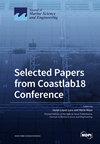利用 NDVI 和 CIE 色调角阈值从哨兵-2 MSI 图像中识别高湍流水中的漂浮绿潮
IF 2.8
3区 地球科学
Q1 ENGINEERING, MARINE
引用次数: 0
摘要
遥感技术被广泛用于获取漂浮绿潮的信息,而基于归一化差异植被指数(NDVI)和浮藻指数(FAI)等指数的阈值法在此类研究中发挥着重要作用。然而,由于这些方法受多种因素的影响,阈值差异很大;特别是在高湍流水(HTW)(NDVI > 0)的情况下,数据提取的误差明显增大。本研究采用了 Sentinel-2 MSI 任务的高空间分辨率多光谱图像作为数据源。研究发现,利用遥感等效多光谱反射率数据和 RGB 方法计算出的国际照明委员会(CIE)色调角对区分漂浮绿潮和 HTW 区域极为有效。对哨兵-2 MSI 图像的统计分析表明,能有效消除 HTW 影响的色调角阈值为 218.94°。利用所确定的 NDVI > 0 和 CIE 色调角 < 218.94°的阈值,对哨兵-2 MSI 图像中 HTW 漂浮绿潮的识别方法进行了试验演示。演示结果表明,该方法有效消除了 HTW 像素(NDVI > 0)引起的误识别,使浮游绿潮的识别及其在真彩色图像中的分布具有更好的一致性。该方法能快速准确地提取 HTW 中的漂浮绿潮信息,为沿海地区绿潮的监测与跟踪提供了一种新的解决方案。本文章由计算机程序翻译,如有差异,请以英文原文为准。
Identification of Floating Green Tide in High-Turbidity Water from Sentinel-2 MSI Images Employing NDVI and CIE Hue Angle Thresholds
Remote sensing technology is widely used to obtain information on floating green tides, and thresholding methods based on indices such as the normalized difference vegetation index (NDVI) and the floating algae index (FAI) play an important role in such studies. However, as the methods are influenced by many factors, the threshold values vary greatly; in particular, the error of data extraction clearly increases in situations of high-turbidity water (HTW) (NDVI > 0). In this study, high spatial resolution, multispectral images from the Sentinel-2 MSI mission were used as the data source. It was found that the International Commission on Illumination (CIE) hue angle calculated using remotely sensed equivalent multispectral reflectance data and the RGB method is extremely effective in distinguishing floating green tides from areas of HTW. Statistical analysis of Sentinel-2 MSI images showed that the threshold value of the hue angle that can effectively eliminate the effect of HTW is 218.94°. A test demonstration of the method for identifying the floating green tide in HTW in a Sentinel-2 MSI image was carried out using the identified threshold values of NDVI > 0 and CIE hue angle < 218.94°. The demonstration showed that the method effectively eliminates misidentification caused by HTW pixels (NDVI > 0), resulting in better consistency of the identification of the floating green tide and its distribution in the true color image. The method enables rapid and accurate extraction of information on floating green tide in HTW, and offers a new solution for the monitoring and tracking of green tides in coastal areas.
求助全文
通过发布文献求助,成功后即可免费获取论文全文。
去求助
来源期刊

Journal of Marine Science and Engineering
Engineering-Ocean Engineering
CiteScore
4.40
自引率
20.70%
发文量
1640
审稿时长
18.09 days
期刊介绍:
Journal of Marine Science and Engineering (JMSE; ISSN 2077-1312) is an international, peer-reviewed open access journal which provides an advanced forum for studies related to marine science and engineering. It publishes reviews, research papers and communications. Our aim is to encourage scientists to publish their experimental and theoretical results in as much detail as possible. There is no restriction on the length of the papers. The full experimental details must be provided so that the results can be reproduced. Electronic files and software regarding the full details of the calculation or experimental procedure, if unable to be published in a normal way, can be deposited as supplementary electronic material.
 求助内容:
求助内容: 应助结果提醒方式:
应助结果提醒方式:


